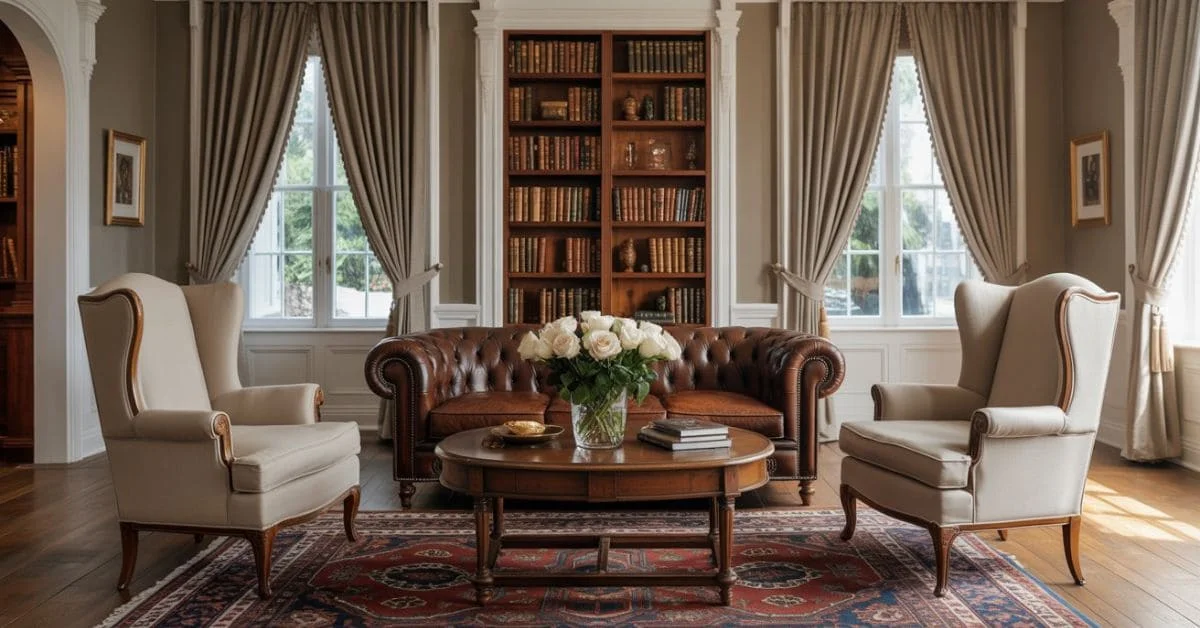Traditional interior design has an undeniable way of wrapping us in warmth and history the moment we step into a room. Ever wondered how a simple molding detail or a perfectly placed wingback chair can transport you to a grand estate from centuries past? In this article, you’ll discover how to capture that timeless elegance in your own home no trust fund required.
You’ll explore essential elements like symmetry, warm color palettes, and rich millwork, plus budget-friendly tips for sourcing stunning reproductions. We’ll introduce you to iconic furniture think Chippendale curves and Louis XVI accents then guide you room by room, from living rooms cozy with Persian rugs to kitchens dressed in wainscoting. Finally, learn how to blend in modern smart-home tech and keep your heirloom pieces looking their best for years to come.
Table of Contents
Essential Elements of Traditional Interior Design
When you walk into a room and everything just feels “right,” you’re often experiencing good traditional design at work. Here’s how to bring that timeless warmth into your own home:
Embrace Symmetry in Room Design
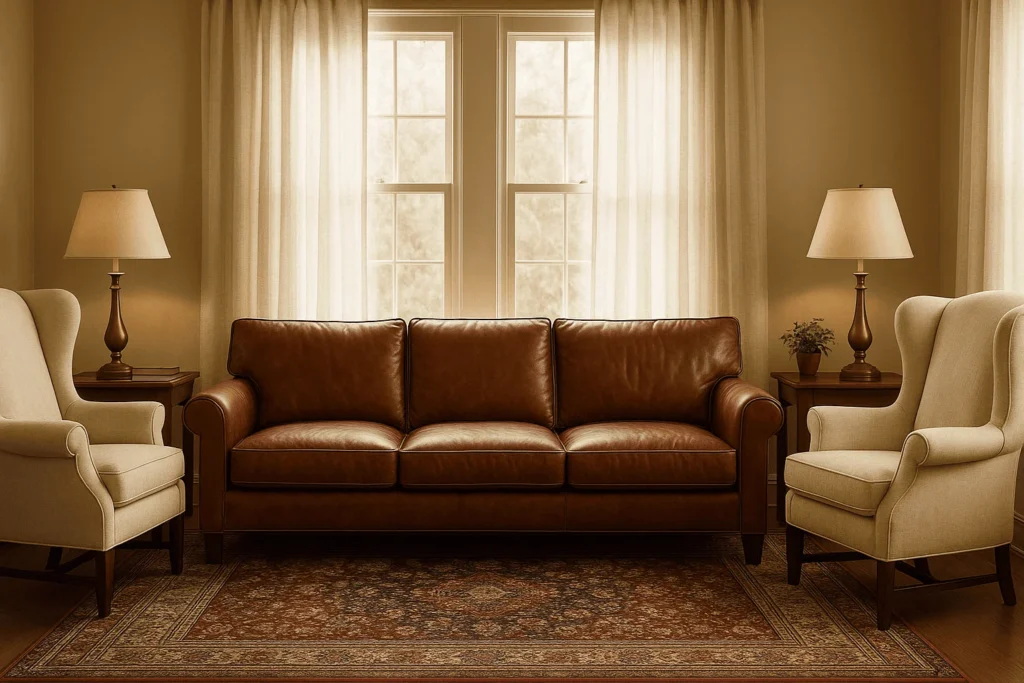
Think of symmetry as visual balance pairing two identical lamps on a console table or flanking a sofa with matching wingback chairs. You don’t need to go full mirror image; even a loose version, like two similar accent chairs on either side of a coffee table, creates that comforting, organized feel. Try arranging seating so everyone faces each other it makes conversations flow naturally.
Layer Warm Color Palettes and Patterned Area Rugs
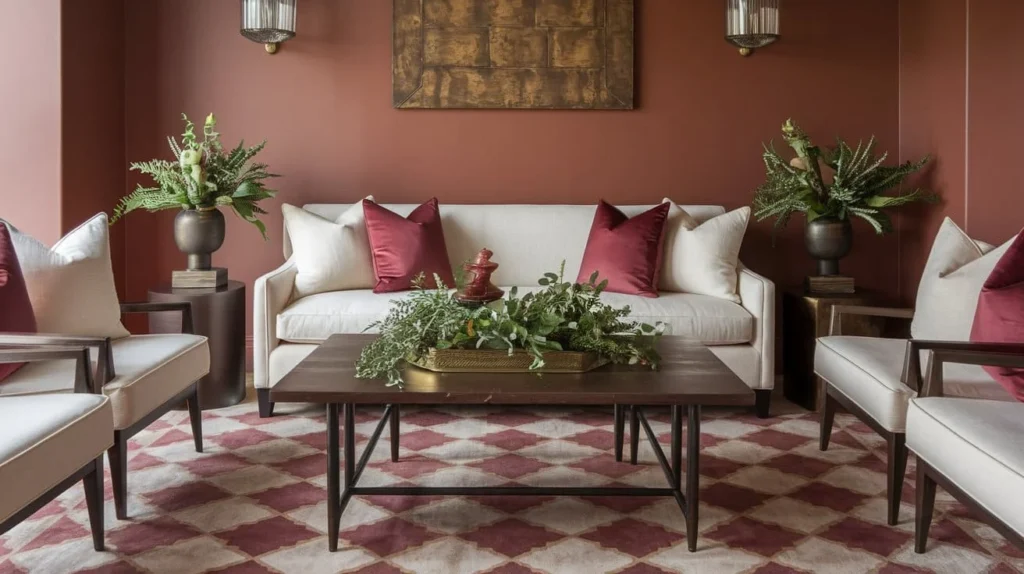
Traditional spaces love rich, inviting hues: deep creams, muted golds, and soft terracottas. Use these on walls or through textiles like throw pillows and drapes. Then anchor your layout with a patterned area rug think a Persian rug or a vintage-inspired geometric print. The rug not only zones the space, it adds texture and that heritage style vibe. Pro tip: pick up a few coordinating accent colors from the rug to sprinkle through cushions or artwork for a pulled-together look.
Show Off Crown Molding, Wainscoting, and Architectural Millwork

These details are the “bones” of traditional design. Crown molding makes a ceiling feel higher and grander, while wainscoting adds instant character to hallway walls or dining rooms. If you’re on a budget, you can paint inexpensive stock millwork to match your trim, then highlight it with a slightly darker wall color so the grooves pop. For a bit of DIY thrill, add a simple picture-frame molding on lower walls: it’s surprisingly easy to install and instantly elevates a room.
By focusing on balanced layouts, cozy colors, and classic millwork, you’ll create a space that feels both lived-in and timeless exactly what traditional interior design is all about.
Budget-Friendly Traditional Interior Design Ideas
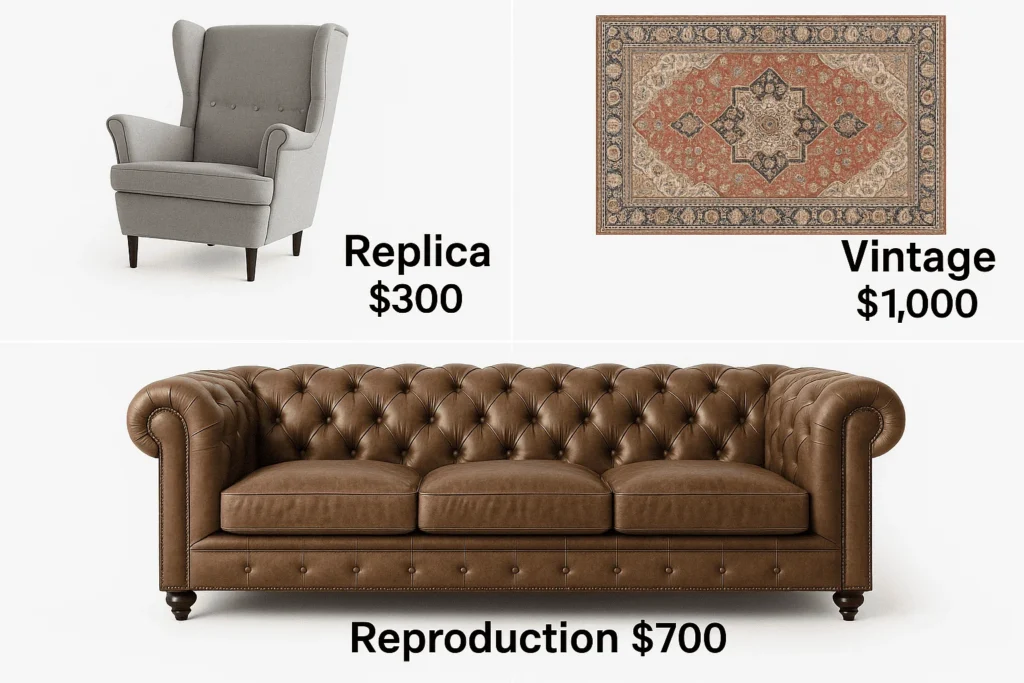
You don’t need a mansion or a trust fund to enjoy the warmth of traditional interior design. Here’s how to capture that heritage style without breaking the bank:
Source Affordable Reproductions vs. Antiques
Hunting for genuine antiques can be thrilling but pricey. Instead, look for well-made reproductions online or at local consignment shops. A Chesterfield sofa replica in faux leather can cost as little as $600, while an original might run into the thousands. Websites like Ethan Allen outlets or Ralph Lauren Home sales often mark down classic pieces, letting you snag regal shapes without the royal price tag.
DIY Décor: Painting Millwork and Refinishing Wood Finishes
You can transform stock crown molding and wainscoting from plain to polished with a fresh coat of paint. Choose a semi-gloss white to make your trim pop against a warm cream or soft taupe wall. For existing furniture, test a rub-on stain to refresh mahogany or oak dressers you’ll spend under $30 on supplies and breathe new life into family heirlooms or thrift-shop finds.
Cost-Breakdown Examples for Key Pieces
- Chesterfield Sofa:
- Antique in good condition: $2,500–$4,000
- High-quality reproduction: $600–$1,000
- Persian Rug (5×8 ft):
- Hand-knotted vintage: $800–$1,200
- Machine-made inspired pattern: $100–$250
- Wingback Chair:
- Restored antique: $700–$1,200
- Modern replica: $200–$400
By comparing these price points, you can pick where to splurge and where to save. For instance, invest in a genuine Persian rug if you love its intricate motifs then offset that cost by choosing a reproduction wingback chair.
With a mix of savvy shopping, a splash of paint, and a bit of elbow grease, you’ll have a traditional interior that feels authentic and inviting without a regal budget.
Iconic Furniture Pieces and Notable Entities
Certain pieces and names conjure up the soul of traditional interior design, and learning a bit about them can help you mix history with your own personality:
Thomas Chippendale and Queen Anne Influences
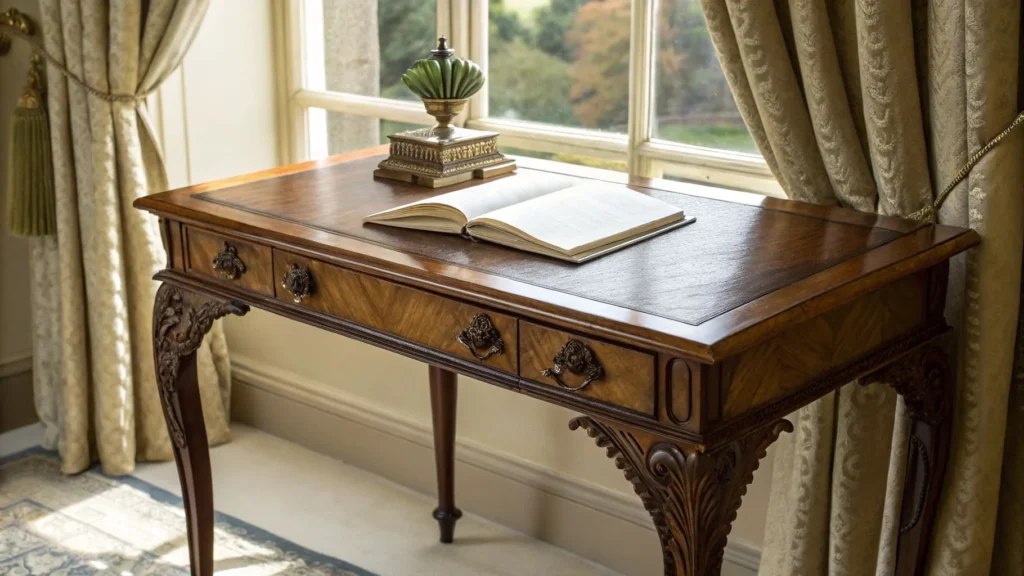
Thomas Chippendale’s designs from the 18th century introduced graceful curves and ornate carving, while the Queen Anne style reshaped furniture with its cabriole legs and shell motifs. If you spot a side table or cabinet with gently flowing legs and a subtle scalloped apron, you’re looking at their influence. To bring this home, hunt for one statement Chippendale-inspired piece like a small writing desk and pair it with simpler surrounds. That single flourish of artful carving will anchor the room without overwhelming your space.
Wingback Chairs & Louis XVI Style Accents
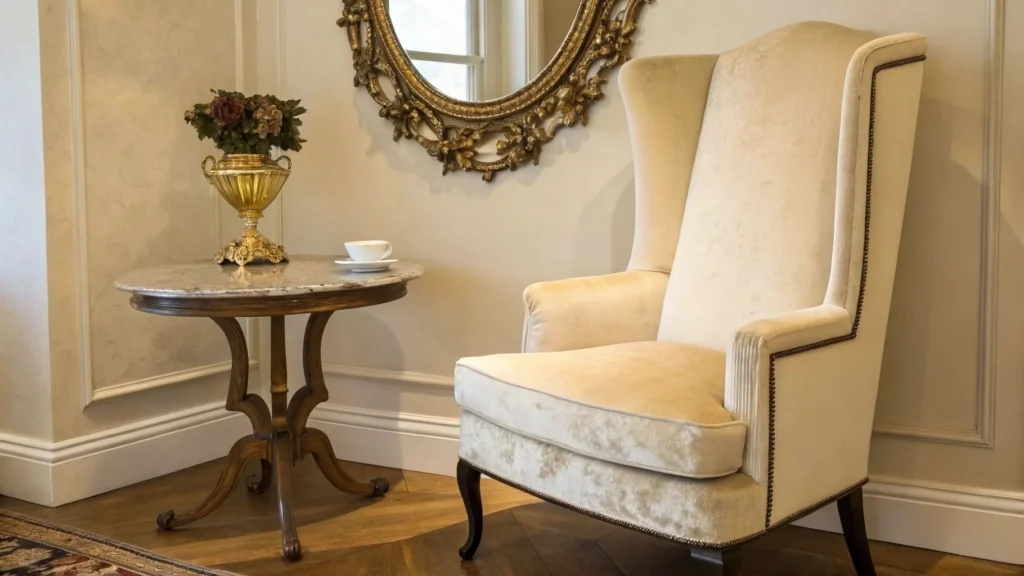
A wingback chair isn’t just comfy; its tall sides and enveloping “wings” were originally designed to keep out drafts smart and cozy. Slip one beside a fireplace or reading nook, drape it with a soft throw, and you’ve created an instant invitation to linger. For a touch of French flair, look for chairs or ottomans with Louis XVI details think straight, tapered legs and delicate carved rosettes on the frame. A small accent in this style can lend aristocratic elegance without needing an entire suite.
Incorporating Ralph Lauren Home or Ethan Allen Reproductions
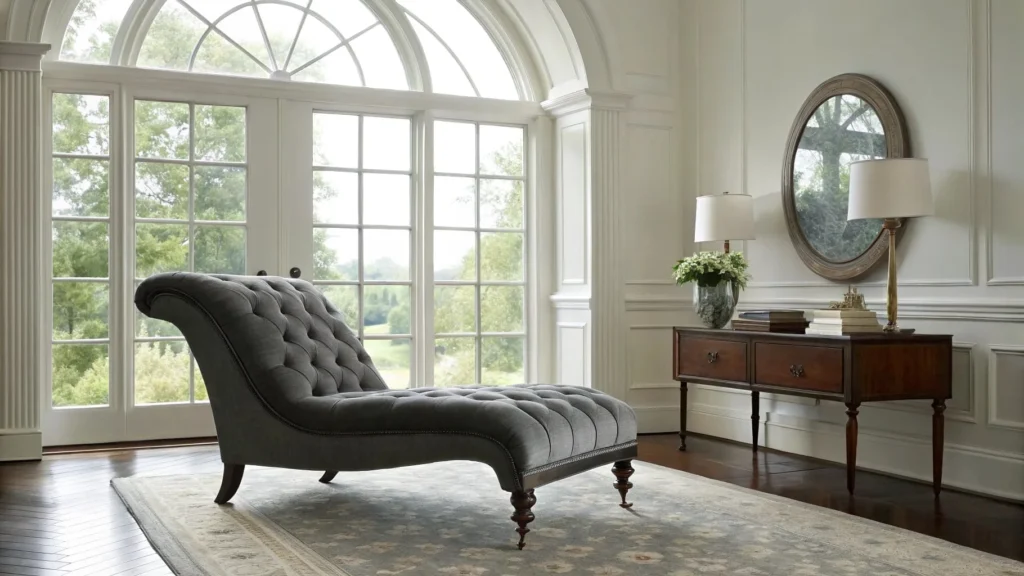
Brands like Ralph Lauren Home and Ethan Allen excel at translating classic silhouettes into more accessible collections. Browse their outlets or online sale sections for seasonal markdowns on tufted chaises, mahogany-finish buffets, or tailored upholstered benches. When you bring home a piece from these collections, treat it as the “hero” of the room by placing it where your eye naturally rests at the end of a hallway, in front of a bay window, or as the centerpiece of your living area.
By choosing one or two iconic shapes whether a Chippendale-style desk, a wingback reading chair, or a Louis XVI mirror you give your space a recognizable nod to tradition. Then balance these “star” pieces with more understated furnishings and textiles, and you’ll have a home that honors history while reflecting your own style.
Architectural Millwork and Rich Wood Finishes
Millwork is the quiet hero of traditional interior design those moldings, trims, and built-in shelves that give your home personality. Here’s how to pick and care for the right pieces, and make wood finishes sing:
Choose and Care for Heritage-Style Millwork
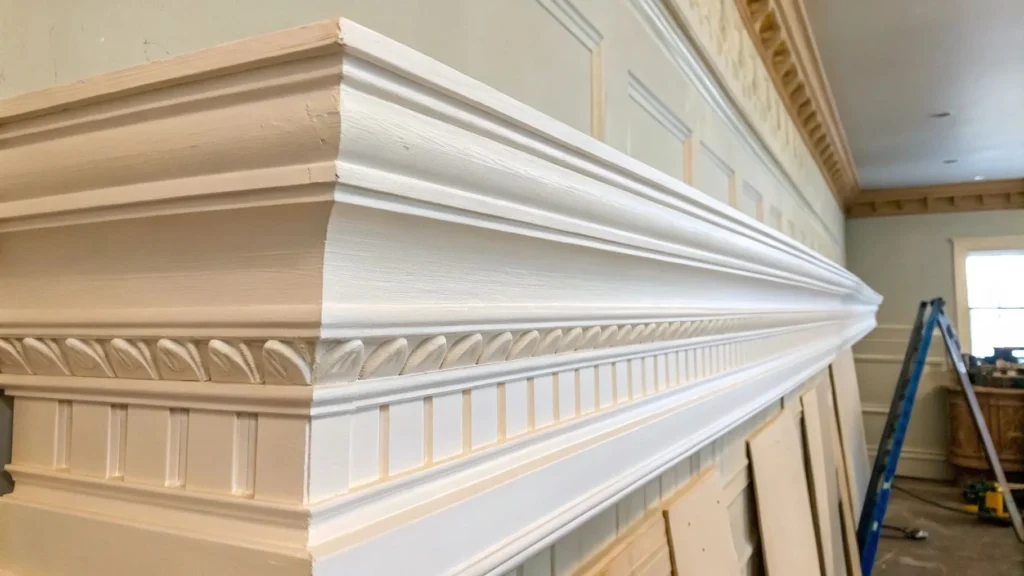
Start by noticing the profiles you love: is it a simple crown molding with a gentle curve, or a more sculpted dentil pattern? You can find pre-cut stock millwork at your local home center look for clear pine or poplar, which take paint beautifully. When it arrives, give each piece a light sanding to remove any factory sheen, then prime before painting. For upkeep, wipe down surfaces with a damp microfiber cloth every few months to keep dust from settling into grooves. If you spot cracks or nail holes, fill them with wood-graining filler, sand smooth, and touch up paint to keep your trim looking crisp.
Pick the Perfect Stain Tone

Whether you’re working with oak, mahogany, or cherry, the right stain can bring out a wood’s natural warmth. For oak’s pronounced grain, try a medium-brown stain that settles into the grooves this highlights texture without feeling too dark. Mahogany shines with a reddish stain that deepens over time, giving a cozy glow. Cherry wood mellows from light pink-orange to a richer red-brown; start with a pale stain and build up in thin coats until you hit your ideal richness. Always test on a scrap piece or an unseen corner, since lighting and previous finishes can shift the result.
Pair Millwork with William Morris Patterns
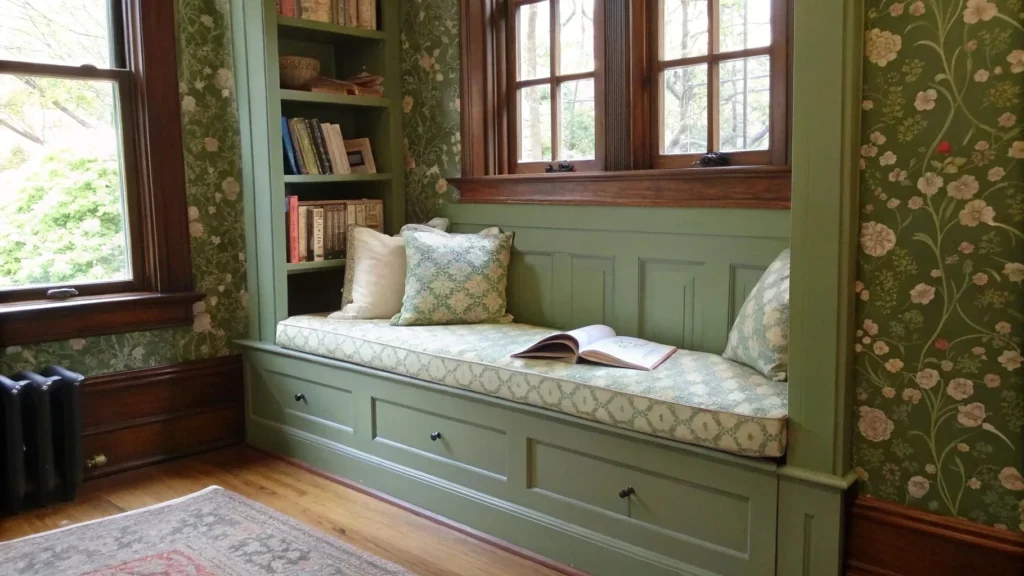
Nothing feels more “heritage” than William Morris’s floral and vine motifs. To balance busy wallpaper or fabric, choose a relatively simple millwork profile an unadorned picture-frame molding works beautifully behind a bold Morris print. Install the molding about two feet off the floor to create a “panel effect,” then hang a lighter solid color above so the wallpaper stands out without overwhelming. In a cozy reading nook, use a Morris-patterned cushion or curtain, and paint the surrounding trim in a muted tone drawn from the pattern like a soft leaf green or muted gold to tie it all together.
Blending Traditional and Contemporary Styles
Bringing together the graceful curves of traditional interior design and the clean lines of modern décor might seem tricky, but it’s all about balance. Here’s how to nail that “transitional” look without feeling like your rooms are stuck in two different eras:
Embrace Transitional Principles

Think of transitional design as a bridge between old and new. Start with a neutral, uncluttered backdrop light walls, simple window treatments, open floor plans and then weave in traditional shapes. For example, pair a sleek, low-profile sofa in a soft gray with a pair of classic wingback chairs on either side. The contrast between the sofa’s straight lines and the chairs’ gentle curves creates visual interest without chaos.
Mix Ornate Accessories with Minimalist Layouts
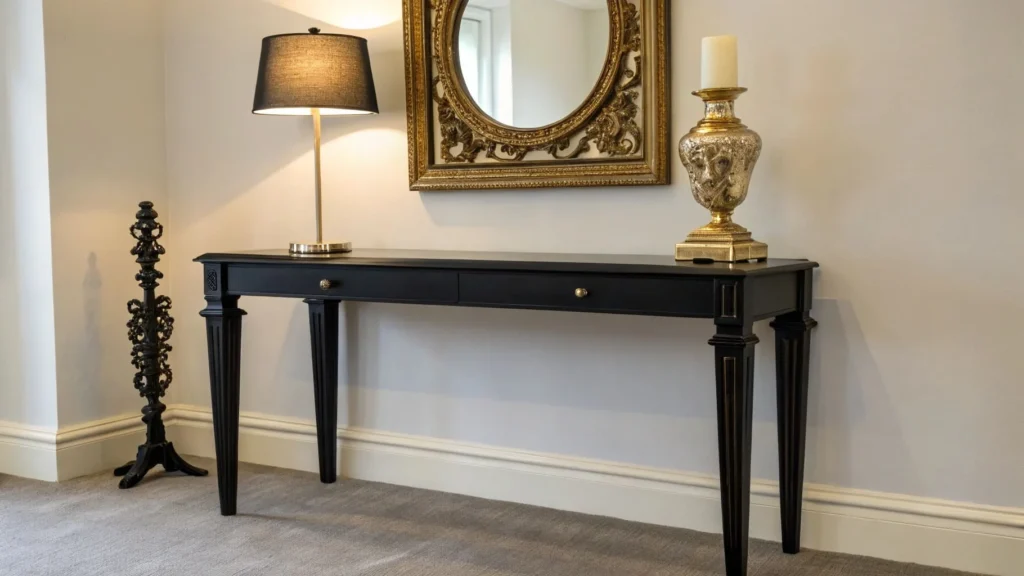
Let a few statement pieces shine. Instead of filling every surface with knick-knacks, choose one or two ornate items a gilded mirror, a Chippendale-inspired lamp base, or a patterned Kravet fabric cushion and give them room to breathe. Place that gilded mirror above a streamlined console table, or lay a Kravet-print throw over a minimalist bench. By keeping surrounding décor simple, your traditional accents feel intentional, not overwhelming.
Use Kravet Fabrics in a Modern Context
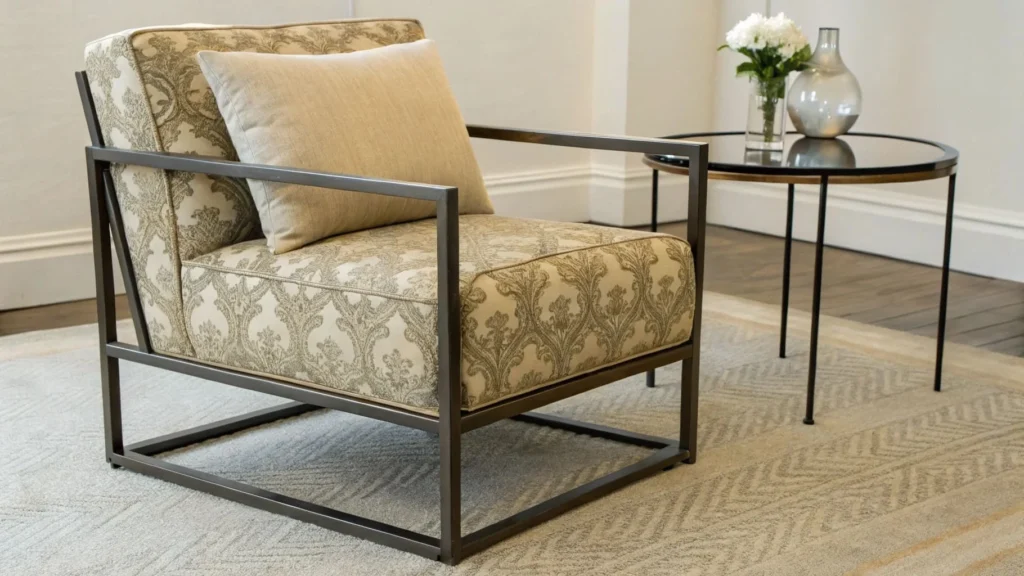
Kravet’s heritage-inspired prints think subtle florals or tone-on-tone Damask can look right at home in a contemporary space. Reupholster a simple accent chair in a muted Kravet fabric, then ground it with a sleek metal coffee table and a plain wool rug. Or swap out solid-color pillows for a set in a Kravet geometric pattern to add warmth and texture. Because Kravet prints often use soft, natural color palettes, they blend seamlessly with modern materials like glass, steel, or lacquer.
Room-by-Room Guide for Traditional Interior Design
Living Room
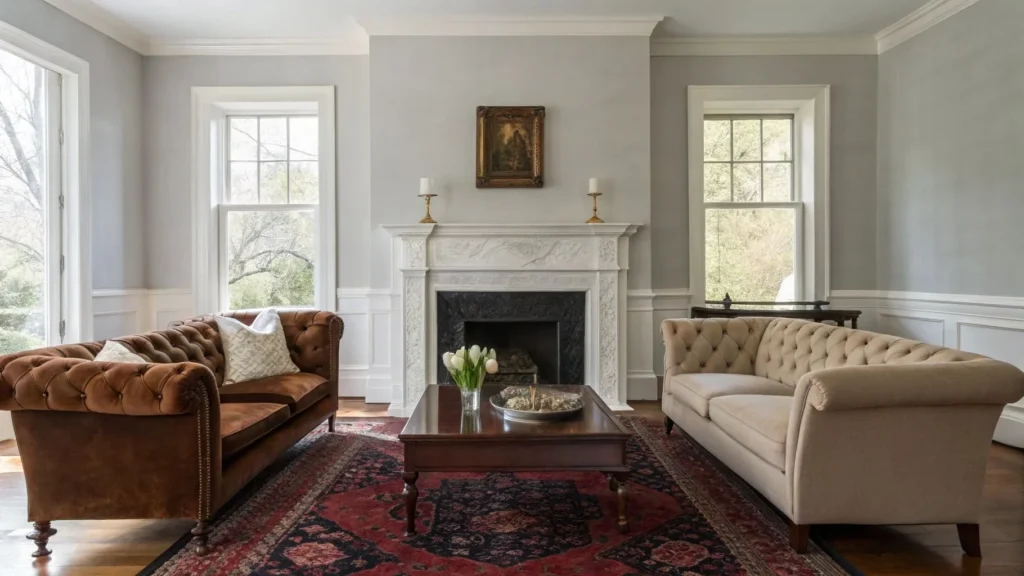
Start by anchoring your seating around a focal-point mantel whether it’s a real fireplace or a decorative surround. Place a Chesterfield sofa facing the mantel and layer in a plush Persian rug beneath the coffee table to define the space. Float two matching armchairs on either side to encourage face-to-face conversation. Add a tray of coffee-table books and a pair of candlesticks on the mantel for instant character.
Kitchen
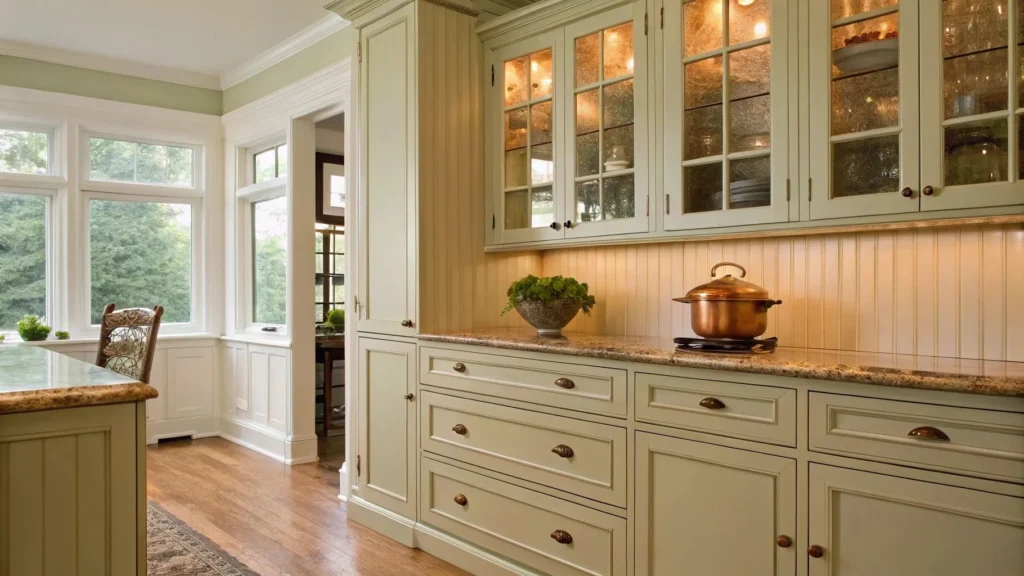
Give your kitchen classic charm with raised-panel cabinetry painted in a soft cream or muted sage. Install wainscoting on a half-wall or along an island’s base to introduce depth and texture. Swap in antique-inspired hardware think oil-rubbed bronze knobs or brass cup pulls to add subtle vintage flair. If you’re handy, replace one cabinet door with glass fronts and style the shelves with white China or copper pots for an heirloom feel.
Bedroom
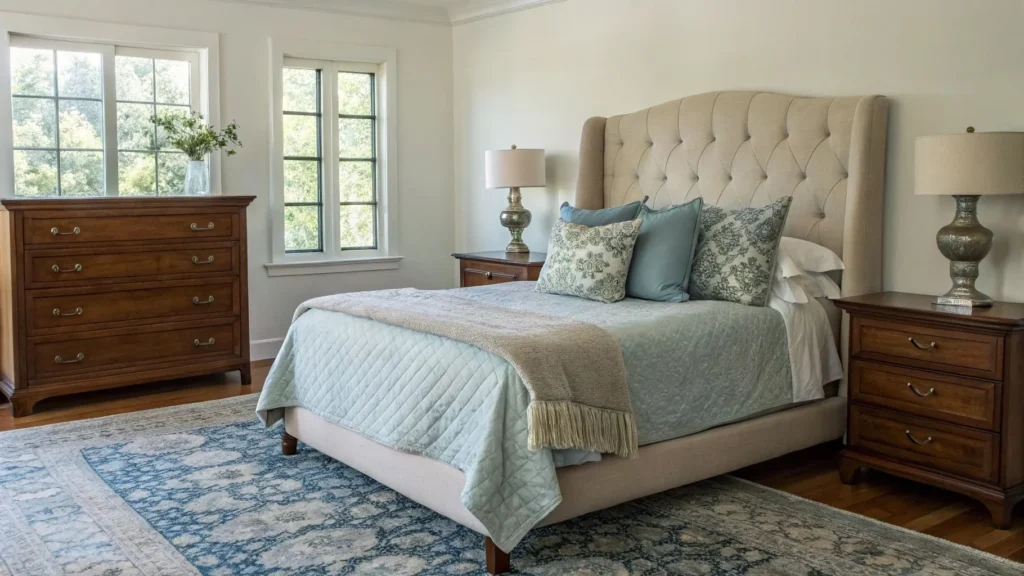
Make your bed the star by choosing a wingback headboard upholstered in a neutral linen or soft velvet. Flank it with turned-leg nightstands or a rich wood dresser oak or cherry finish works beautifully. Layer in heritage textiles like a quilted coverlet and embroidered pillows in muted blues or greens to bring warmth. A small Persian runner at the foot of the bed ties in pattern without overpowering.
Bathroom
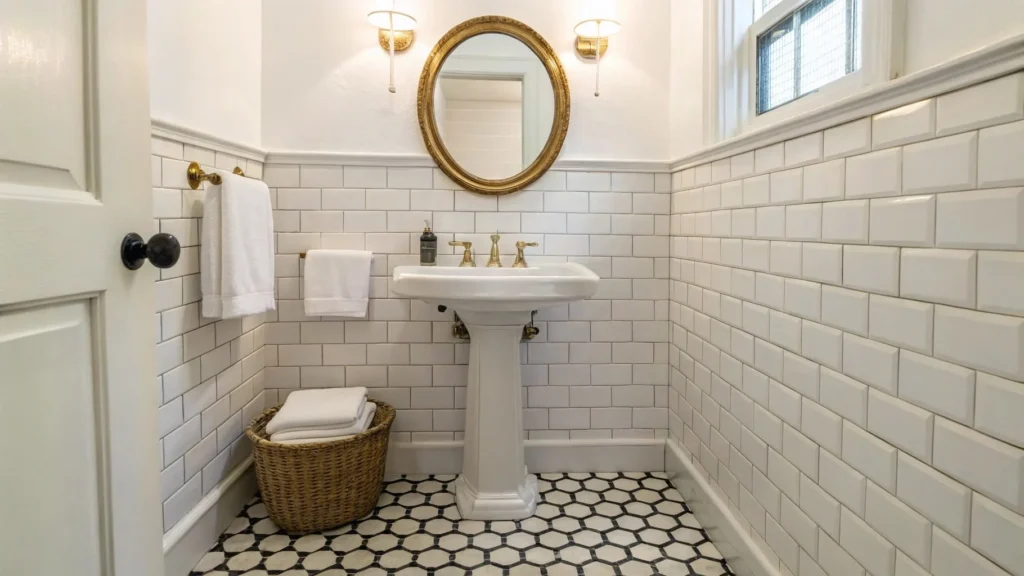
Turn your powder room into a tiny retreat with a classic pedestal sink and vintage-style faucets. Lay patterned tile on the floor hexagon or checkerboard and extend wainscoting up to chair-rail height for instant elegance. Hang a framed antique mirror above the sink, and tuck in a wall-mounted sconce on each side for soft, flattering light.
Home Office
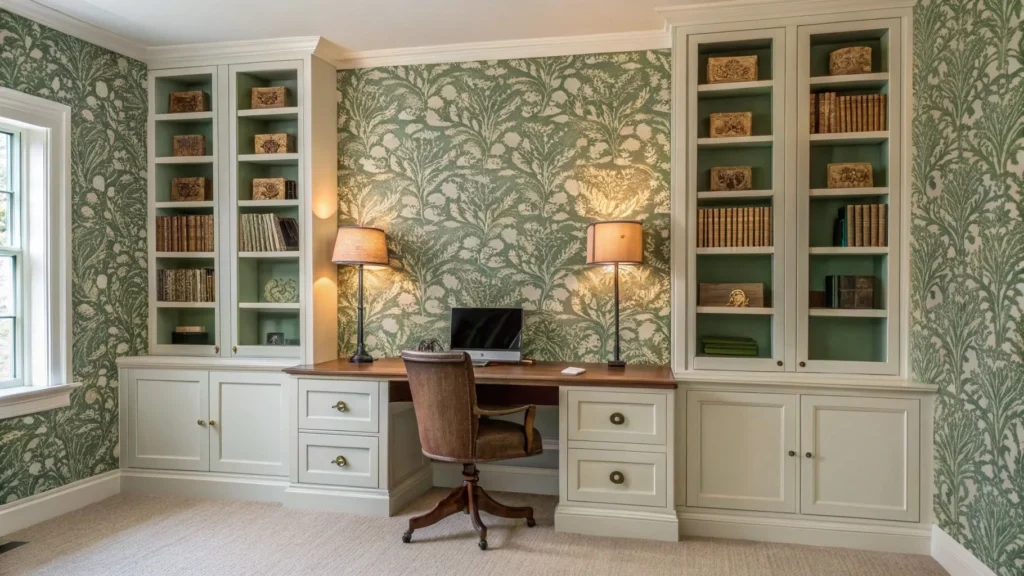
Build in a wall of built-in bookcases painted to match your trim for a cozy library feel. Paper one accent wall with a William Morris wallpaper florals or stylized vines then keep the desk area uncluttered to let the pattern shine. Arrange your desk and chair symmetrically in front of the wallpapered wall, and add matching lamps on either side for balanced task lighting.
Integrating Smart Home Technology into Traditional Interiors
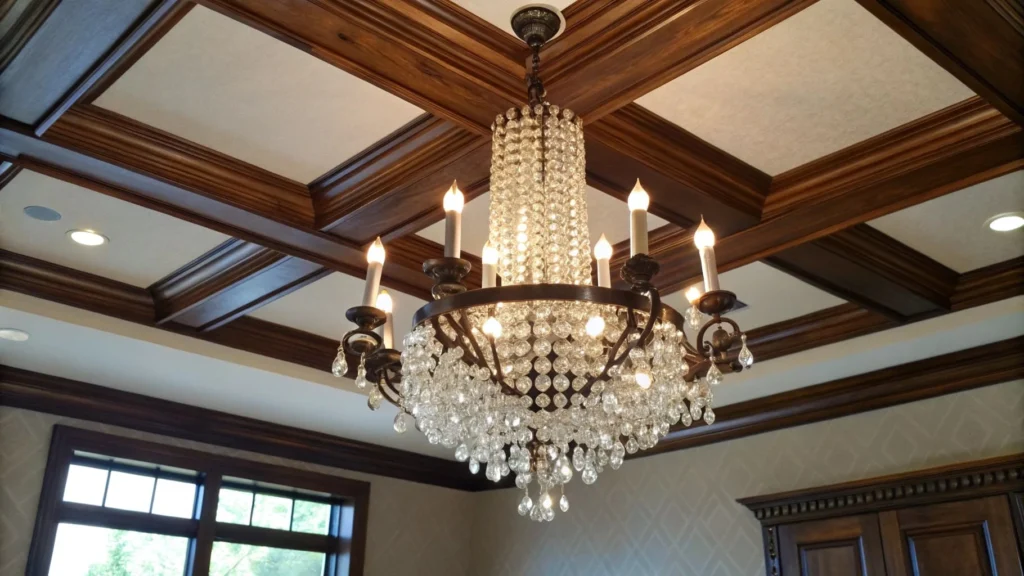
You shouldn’t have to sacrifice modern comfort for classic charm. Here’s how to weave today’s smart home conveniences into your traditional interior design without a single eyesore:
Conceal Sensors Behind Period-Style Trim
Those little motion detectors and temperature sensors don’t have to stick out like a sore thumb. Pick up narrow trim pieces think slender chair-rail profiles or small picture-frame moldings and cut discreet openings in the back so the sensor peeks through. Paint the trim to match your walls or ceiling, and voilà: your smart sensor blends right into the traditional millwork.
Choose Vintage-Inspired Smart Switches and Discreet Speaker Wiring
Not all smart switches look futuristic. Seek out dimmers and toggles finished in antique brass or aged bronze many smart-home brands now offer these styles. Swap them in for your old rocker switches to control lights or fans with a tap or voice command. For hidden audio, run speaker wires behind baseboards or inside crown molding cavities. Then mount ultra-thin speakers above the trim line so your playlists play in every room, but the tech stays out of sight.
Automate Lighting and Climate Control Without Visual Clutter
Smart bulbs fit right into classic chandeliers and lamps no need to replace your favorite fixtures. Pair them with an app or hub, and program scenes like “Morning Tea” or “Evening Read” that adjust brightness and color temperature at the touch of a button. For temperature, tuck a smart thermostat inside a decorative wall box or behind a framed art piece with vents cut out at the top and bottom. This way, your home heats and cools itself seamlessly, and your walls stay gallery-perfect.
By hiding sensors behind trim, choosing switches and speakers with a nod to history, and disguising thermostats and bulbs, you’ll elevate your traditional rooms with effortless smart-home magic enjoying modern ease without compromising timeless style.
FAQs
What defines traditional interior design?
Traditional interior design draws inspiration from 18th- and 19th-century European décor, emphasizing symmetry, rich wood tones, architectural millwork, and classic furnishings like wingback chairs and Chesterfield sofas.
How can I achieve a traditional look on a tight budget?
Mix affordable reproductions with one or two statement antique-style pieces. Refinish thrifted furniture, paint stock millwork, and hunt for sales at outlets like Ralph Lauren Home or Ethan Allen.
Which color palette works best for a traditional home?
Warm neutrals creams, soft taupes, muted golds and accent hues pulled from patterned rugs or William Morris fabrics. These tones create a cozy, inviting backdrop for classic décor.
Can I mix traditional furniture with modern elements?
Absolutely. Start with a neutral, minimalist base clean-lined sofa or open floor plan then layer in ornamental touches like a Chippendale side table or a Kravet-print cushion for a balanced transitional style.
What’s the easiest way to add architectural millwork?
Install pre-cut crown molding, wainscoting, or picture-frame trim from a home center. Prime, paint, and touch up as needed to give any room instant character and depth.
How do I maintain wood finishes and heirloom textiles?
Dust millwork with a damp microfiber cloth, polish or refinish wood surfaces annually, and vacuum rugs regularly. For upholstery, spot-clean with gentle soap and consider professional re-upholstery for well-loved classics.
How can I integrate smart home tech without ruining the traditional look?
Hide sensors behind slim chair-rail moldings, use vintage-style smart switches in antique brass or bronze, and tuck thermostats or speakers behind decorative frames or trim so technology stays out of sight.
